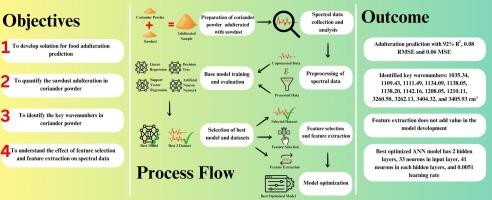IF 8.5
1区 农林科学
Q1 CHEMISTRY, APPLIED
引用次数: 0
摘要
芫荽是一种广泛使用的香料,因其风味、香气和营养价值而被广泛用于各种菜肴和食品中。然而,掺假(如添加锯末)会给食品安全和真实性带来重大风险。本研究旨在通过提供一种利用机器学习辅助傅立叶变换红外光谱的详细方法,提出一种预测芫荽粉中锯末掺假的解决方案。它采用了各种基础模型,包括线性回归(LR)、决策树(DT)、支持向量回归(SVR)和人工神经网络(ANN),用于掺假检测。结果表明,原始数据集和萨维茨基-戈莱平滑数据集(预处理后生成的数据集)的结果更优,验证集的 R2 值分别超过 0.92 和 0.96。这表明,由于掺假水平和光谱特征之间存在复杂的非线性关系,掺假检测中观察到的变异性有 92% 以上是由优化的 ANN 模型解释的。这些发现凸显了机器学习辅助傅立叶变换红外光谱法在准确预测芫荽粉中锯末掺假方面的潜力。这为通过量化掺假水平来改进食品鉴定方法提供了广阔的前景。这项研究还为利用机器学习辅助傅立叶变换红外光谱法量化食品中不同类型的掺假物提供了方向和方法,从而提高食品安全。本文章由计算机程序翻译,如有差异,请以英文原文为准。

Machine learning-assisted Fourier transform infrared spectroscopy to predict adulteration in coriander powder
Coriander is a widely used spice, valued for its flavor, aroma, and nutritional benefits in various cuisines and food products. However, adulteration, such as the addition of sawdust, poses significant risks to food safety and authenticity. This study aims to present a solution for predicting sawdust adulteration in coriander powder by providing a detailed methodology for utilizing machine learning-assisted FTIR spectroscopy. It employs various base models, including linear regression (LR), decision tree (DT), support vector regression (SVR), and artificial neural network, (ANN), for adulteration detection. It was observed that the original dataset and Savitzky–Golay smoothed dataset (dataset generated after preprocessing) yielded superior results by achieving R2 values exceeding 0.92 and 0.96, respectively, for the validation set. It shows that more than 92 % of the variability observed in the adulteration detection is explained by the optimized ANN model due to complex non-linear relationship of adulteration level and spectral features. These findings highlight the potential of machine learning-assisted FTIR spectroscopy in accurately predicting sawdust adulteration in coriander powder. This offers promising prospects for enhancing food authentication practices by quantification of adulteration levels. The study also gives directions and methodology to quantify different types of adulterants in food products using machine learning-assisted FTIR spectroscopy, which can enhance food safety.
求助全文
通过发布文献求助,成功后即可免费获取论文全文。
去求助
来源期刊

Food Chemistry
工程技术-食品科技
CiteScore
16.30
自引率
10.20%
发文量
3130
审稿时长
122 days
期刊介绍:
Food Chemistry publishes original research papers dealing with the advancement of the chemistry and biochemistry of foods or the analytical methods/ approach used. All papers should focus on the novelty of the research carried out.
 求助内容:
求助内容: 应助结果提醒方式:
应助结果提醒方式:


